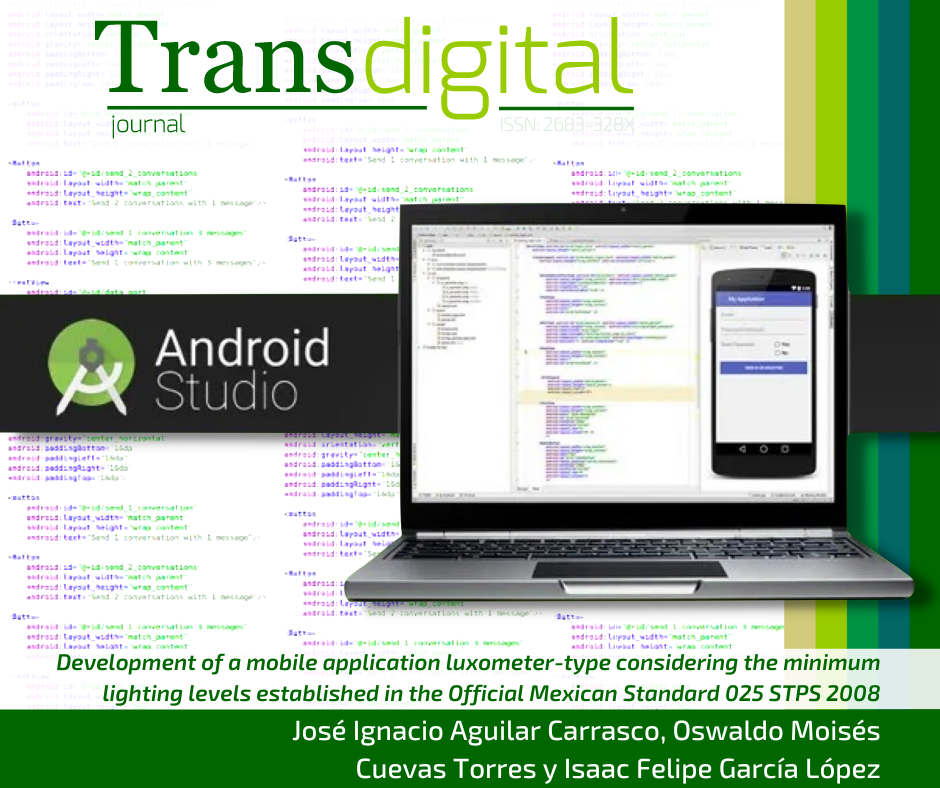Development of a mobile application luxometer-type considering the minimum lighting levels established in the Official Mexican Standard 025 STPS 2008
DOI:
https://doi.org/10.56162/transdigital183Keywords:
mobile application, Android, Android StudioAbstract
Mexico has the Official Mexican Standard 025 of the Ministry of Labor and Social Welfare of 2008, whose aim is to establish the lighting requirements in work centers and provide a safe and healthy environment for workers to perform their tasks. Lighting can be measured with an instrument called a luxmeter, but these are not always available in the workplace. This research developed a mobile application for Android devices that allows lighting measurements to be taken, like a commercial luxmeter. The results of the application also indicate whether the level is adequate as established in the aforementioned standard. The Kanban development methodology and the Android Studio integrated development environment (IDE) with Java, Python (TensorFlow) and PHP programming languages ??were used. To ensure the quality of the results, a sample of readings (n=21) obtained with the application and a commercial luxmeter was taken. Subsequently, its normality was verified through the Ryan-Joyner test and a t-test for independent samples (?=0.05) was performed. The results confirmed the normality of the data and the non-rejection of the hypothesis of equality of means in the t-test of independent samples. Therefore, the results of the sample obtained with the application did not have a significant mean difference with those obtained from the commercial luxmeter sample.
References
Cabeza, M. y Cabeza, M. (2010). Evaluación de los Riesgos por Iluminación en los Puestos de Trabajo de Oficinas PDVSA a través de un Programa de Computación. SABER. Revista Multidisciplinaria del Consejo de Investigación de la Universidad de Oriente. https://www.redalyc.org/articulo.oa?id=427739443009
Calvo, A. (1998). El teléfono en España antes de Telefónica (1877-1924). Revista de historia industrial. 58-91.
Ciuró, J., Jiménez, J., Moura, L. y Camargos, G. (2020). Impacto Económico y social de Android en México. Bain & Company. https://www.bain.com/contentassets/a9200a057a0241b8963c05a9b09e33fe/impacto-economico-y-social-de-android-en-mexico-1.pdf
Guillén, M. (2006). Ergonomía y la relación con los factores de riesgo en salud ocupacional. Revista cubana de enfermería. 22(4). http://scielo.sld.cu/scielo.php?script=sci_arttext&pid=S0864-03192006000400008
Herraiz, G. (2012). Android. Historia de la informática. Universidad Politécnica de Valencia. https://histinf.blogs.upv.es/files/2012/12/ANDROID-Gabriel-Herraiz-Ant%C3%B3n.pdf
Hohensee, B. (2014). Introducción a Android Studio. Incluye proyectos reales y el código fuente. Babelcube Inc.
INEGI. 2021. Comunicado de prensa No. 352/21. https://www.inegi.org.mx/contenidos/saladeprensa/boletines/2021/OtrTemEcon/ENDUTIH_2020.pdf
Kayser, B. (2007). Higiene y seguridad industrial. Atlantic Internacional University. https://www.aiu.edu/spanish/publications/student/spanish/180-207/PDF/Higiene-y-seguridad-Industrial.pdf
Naranjo, D., Buenaño, D. C. y Mejía, I. T. (2016). Evolución de la tecnología móvil. Camino a 5G. Revista Contribuciones a las Ciencias Sociales. http://www.eumed.net/rev/cccss/2016/04/5G.html
NOM-025-STPS-2008, Secretaría del Trabajo y Previsión Social, Ciudad de México, DOF, 31 de Diciembre de 2008, citado el 06-01-2023. http://dof.gob.mx/nota_detalle.php?codigo=5076393&fecha=30/12/2008
Polanco, K., & Taibo, J. L. (2011). Android el sistema operativo de Google para dispositivos móviles. Negotium, 7(19). https://sede.educacion.gob.es/publiventa/PdfServlet?pdf=VP18117.pdf&area=E
Rodríguez, O., Hernández, R., Torno, L., García, L. y Rodríguez, R. (2005). Telefonía móvil celular: origen, evolución, perspectivas. Ciencias Holguín. https://www.redalyc.org/articulo.oa?id=181517913002
Ruelas, A. (2010). El teléfono celular y las aproximaciones para su estudio. Nueva época, 14. http://www.scielo.org.mx/pdf/comso/n14/n14a6.pdf

Downloads
Autor de correspondencia
El autor de correspodencia se identifica con el siguiente símbolo: *Published
How to Cite
License
Copyright (c) 2023 José Ignacio Aguilar Carrasco, Oswaldo Moisés Cuevas Torres, Isaac Felipe García López

This work is licensed under a Creative Commons Attribution 4.0 International License.
All articles in Transdigital are licensed under a Creative Commons Attribution 4.0 International License. Authors hold the copyright and retain publishing rights without restrictions.









